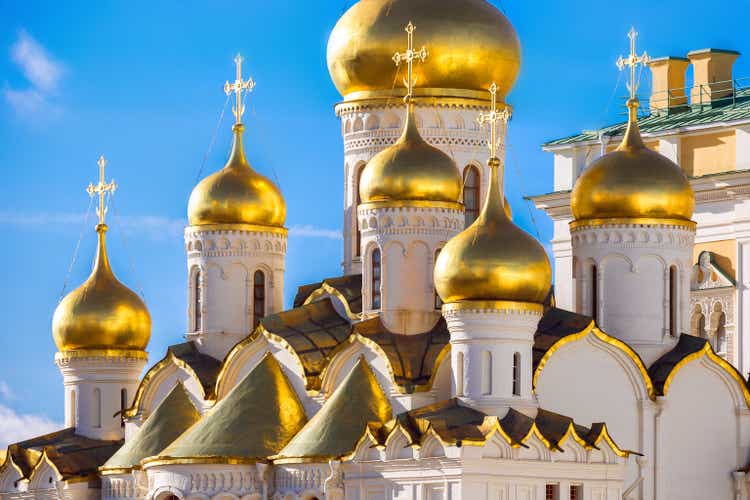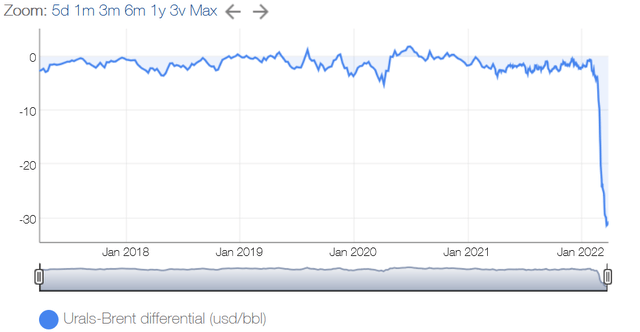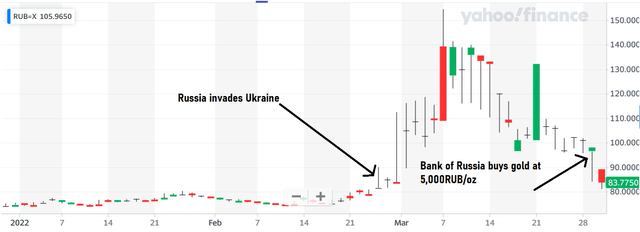
Is Russia moving to a gold standard
Mordolff/E+ via Getty Images
I believe the Bank of Russia is quickly moving to a gold standard. Here’s how I think they are going to pull it off.
First Buy The Domestic Russian Gold Supply
On March 25, the Bank of Russia announced that it would start buying gold from Russian banks at 5,000 Rubles per gram. At current exchange rates, that’s a steep discount, at least at first glance. What’s the point of the Bank of Russia buying gold at a discount from its member banks, and why would its member banks sell gold at all at these rates unless forced to do so? You could try to say that the Bank of Russia is forcing the sales. Perhaps, but I don’t think it’s necessary to say so.
Take a look at the chart below.

Brent Urals price differential (Neste)
This is the price differential between Brent crude and Urals crude, in other words the difference between the price of oil outside Russia and oil inside Russia. True, the two grades of oil are not exactly the same, but the arbitrage has clearly exploded since the Ukraine invasion began. The extreme differential is obviously because of sanctions that cut off much of the Russian oil market to the rest of the world, and so whatever Russian oil can get through the firewall is offered at a major discount.
But the United States and its allies also are sanctioning Russian gold. And what does that do? It creates the same sort of price differential and arbitrage opportunity. Russian gold is much cheaper than non Russian gold now because Russian gold is cut off from the rest of the gold market and there’s risk of retaliation if you get caught buying it from Russia. The London Bullion Market Association has already banned Russian gold from its registries.
And so if you’re a Russian bank and you have some gold and you can’t sell it to someone out of the country except at a steep discount, and the Bank of Russia is offering to buy it from you at less of a discount, that’s still a premium for you, and the Bank of Russia splits the difference, increases its gold reserves, and in that way stabilizes the Ruble. Below is the Ruble/Dollar exchange rate since the beginning of the year.

Ruble US Dollar Exchange Rate (Yahoo Finance)
Next Strengthen the Ruble And Drain Gold From the West
The next step in this process is to strengthen the Ruble internationally. To do that, Russia has announced that it will only sell energy for Rubles to unfriendly countries, in other words countries sanctioning Russia. By doing so, demand for the Ruble picks up, which could eventually turn the 5000RUB discount internationally into a premium, encouraging more gold flows into Russia internationally as well, and further draining the West of its gold reserves in favor or Russia.
This would stop the domestic flow of gold into the Bank of Russia, but it would encourage international flows, the logical next step after domestic supplies run dry.
Why can the West not see what is happening? Because they’re myopic. The mainstream financial press is so focused on the “Russia selling gold” angle because they’re deeply Keynesian that they do not understand that gold is money, rather than the paper that they print, and that the paper only has value because it is still exchangeable for gold. This entire article from the Wall Street Journal for example is completely focused on Russia selling gold, rather than Russia buying it, which is what they are actually doing.
Finally, Turn the Ruble Into a Gold Substitute
True, Russia eventually needs to “sell gold” at some point to get stuff it needs. But Russia can do this without actually moving any of its gold. How so? It can simply declare the Ruble a hard gold substitute at a fixed exchange rate. In other words a gold standard. But before it does that, it first must make sure it has the required reserves if tested, which it’s now doing by splitting the arbitrage offered by Western powers that have sanctioned its gold and cut it off from global markets.
The Bank of Russia must also make sure its monetary policy is tight enough (now at 20% interest rates) to hold the line. Then it can insist on payment for Russian commodities in Rubles, now hard gold substitutes.
That’s the beauty of a money substitute, AKA a gold substitute in a gold standard system. The currency takes the place of gold, so you don’t have to physically move the stuff, which is a pain and expensive.
Western financial thought has this idea that if they cheapen Russian gold by sanctioning it, they’re hurting Russia by lessening the amount of stuff they could potentially buy with that gold. In fact, they’re actually helping Russia by encouraging gold inflows into the country and making it much cheaper for the Bank of Russia to amass much more gold to back the Ruble at a credible rate when the time comes.
When is that time? Nobody knows for sure, or if it will ever indeed come, but the 5,000RUB/gram gold window closes June 30. What happens then? Does the Ruble become a fully backed gold substitute?
Rather than speculate on the Ruble itself, it’s easier, safer, and more practical just to buy gold and let the Bank of Russia decide what it wants to do with its own paper.


Be the first to comment